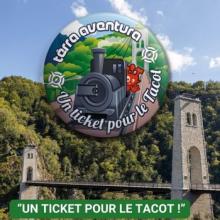


Few aspects of our local lifestyle are more important to both residents and visitors alike than the really good food available everywhere here. You can find it in simple country inns or village bistros, brasseries, or establishments with Michelin stars. But we’re not just talking about restaurants; it all starts literally at ground level, in fields, orchards and vineyards, whereproduce of the highest quality begins its life.
Many of our products have official quality certification such as AOP or Label Rouge; and these are not awarded lightly.
They are all to be found on the numerous markets. Towns and many villages have once or twice weekly markets throughout the year; whilst in summer, Local Farmers’ Markets, at which only producers from the surrounding communities can trade, spring up in many places.
Every Saturday morning, the dynamic town of Brive sees crowds of shoppers in search of the finest seasonal produce flocking to the excellent Georges Brassens covered market on the Place de la Guierle. There are also traditional open food markets on Tuesday and Thursday mornings, so there’s plenty of opportunity to see and sample our many and varied specialities at their best. Discover also the Tulle markets on Wednesday and Saturday and Objat market on Sunday.
If you want the fresh black truffle experience, you’ll have to come here between November and February when they ripen and the truffle market in Brive is crowded with producers, dealers, restaurateurs and visitors inhaling the inimitable aroma.
Lush green pastures and the famous chestnut-coloured Limousin cattle combine to produce excellent milk-fed, naturallyraised veal (no cages). The tender, delicate pinkish-white meat has Label Rouge status; and Objat’s market is recognised for the consistently high quality of the meat sold here.
Unsurprisingly, delicious alcoholic drinks are part of our culinary heritage; and if you’d like to know more (and taste some), you can’t do better than to visit the Denoix Distillery, installed in the heart of Brive since 1839.
Apéritifs and liqueurs based on walnuts and red fruits grown locally, macerated, distilled and blended with fine Armagnac or Cognac are made, along with La Moutarde Violette de Brive (a mild, tasty mustard flavoured with grape must). The same equipment, methods, recipes and ingredients as in the 19th C. are still used - and the results are every bit as good as then!
A very pleasant way of trying our traditional cuisine is to visit a Ferme Auberge or Farm Inn, where you can enjoy a meal on a working farm, prepared largely from their own produce.
The Dordogne valley is home to Vin Paillé, a sweet wine made by a small number of winemakers who keep this centuries-old tradition alive. The bunches of grapes are hand-picked, laid on trays and allowed to dry naturally before being pressed. This concentrates the sugars and aromas, giving a white and a red wine that can be served chilled as an apéritif, or with foie gras, cheeses and desserts. More info
Having obtained the bronze medal in the World Fair of 1878, the wine of Branceilles had fallen into oblivion, victim of the phylloxera. Eight farmers made it be reborn in 1987, baptizing it "Mille et une pierres" in memory of the ingratitude of the ground. The vineyard (45 % of Cabernet franc, 30 % of gamay and 25 % of merlot) gives 200 000 bottles of red and rosé wine. Tours, tastings and sale of estate wines. More info
A small vineyard on slate soil. Tours, tastings and sale of estate wines. More info
These walnuts are produced in the Corrèze, the Lot and the Dordogne (Perigord is the old name of the Dordogne département). This nut originally came to the area with the Romans, but has made itself thoroughly at home here, and walnut groves are to be seen almost everywhere. Apart from being sold in shell, walnuts are transformed into all kinds of delicious cakes, biscuits, confectionery (chocolate walnuts are seriously good) and oil. They are also distilled into liqueurs and spirits, or macerated to make walnut wine, a pleasant apéritif. They garnish salads, accompany cheeses, and are very good for you into the bargain. The Perigord Walnut Route winds its way through the walnut-growing landscapes of the Corrèze, Lot and Dordogne valleys, offering a choice of four main itineraries based around four A.O.P. Noix du Périgord varieties. More info
Apple orchards in Corrèze are dedicated to growing this fruit, mostly the rosy and sweet« golden delicious » variety. In 2004, Limousin apples were awarded the prestigious “AOP” label. (an award guaranteeing their exceptional quality).
Till this day, it is still the only apple in France with this label. Most of Limousin’s orchards are on the «route de la pomme » (apple route) near Objat, St Yrieix and Pompadour. Visit them and taste our ciders and apple juice. More info
Wild blueberries grow in the Monédières area. These berries have been organic for hundreds of years: they don't require any fertlizer, and the bushes they grow on only need to be trimmed once every 5 or 10 years. Picking takes place in the summer and is a bit tricky : the blueberries are handpicked, using a type of "comb".
The Dordogne Valley is very fertile, with earth enriched by flood deposits over the millennia. Sweet, succulent, sun-ripened strawberries perfume our markets. Indeed, Beaulieu-sur-Dordogne holds the Strawberry Festival every May, with a market, food stalls, a giant strawberry tart and various activities to entertain visitors.
Foires grasses in Brive-la-Gaillarde
November, December, January and February
Markets specialising in the sale of foie gras, truffles, goose and duck products.
Strawberry Festival in Beaulieu-sur-Dordogne
May
Strawberry market, giant tart, food stalls, hot-air ballooning etc.
Festival of regional cattle breeding in Brive-la-Gaillarde
August
Presentation of cattle, goats, pigs, sheep, draught horses, poultry and birds. A real farm in the middle of the town with different animations. Horse drawn carriages and pony riding. Sale and tasting of regional products, kitchen demonstrations. Processions of confraternities.
Chestnut Festival in Beynat
October
Market selling chestnuts in various forms and products based on them. Traditional presentation and tasting of The Giant Chestnut on Sunday afternoon.
Local Farmer's Markets
In summer, these markets are a great opportunity to meet local farmers and find out about the rich and diverse produce of the Dordogne valley, from fruit and vegetables to conserves, pâtés and jams. Only producers from the surrounding area are allowed to have stalls, and there is usually a festive atmosphere, with the opportunity to stay and make a meal from the products you have bought.
Summer markets :
- Monday : Beaulieu-sur-Dordogne* • Eygurande* • Ségur-le-Château*
- Tuesday : Beynat* • Masseret (Lamongerie Lake)*• Ussel* • Voutezac (Le Saillant)*
- Wednesday : Chartrier-Ferrière* • Meymac • Naves • Saint-Pardoux Corbier*
- Thursday : Ayen* • Monceaux-sur-Dordogne* • Sainte-Féréole* • Sarran*
- Friday : Neuvic* • Saillac* • Sainte-Fortunade* • Treignac • Uzerche*
(*) festive market.

Répondez à notre enquête et gagnez un des nombreux séjours mis en jeu !

Embarquez pour une Micro Z’aventure, sur les traces du Transcorrézien !